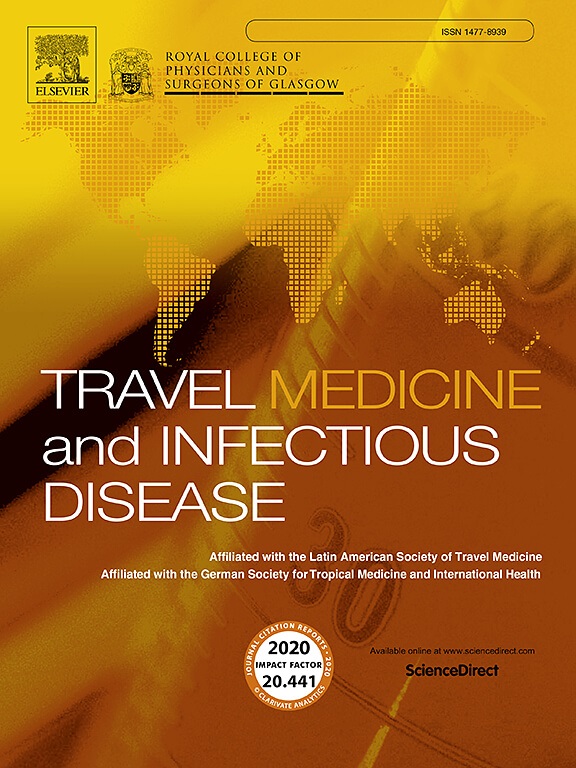Transcriptomic analysis of chronic chikungunya in the Reunionese CHIKGene cohort uncovers a shift in gene expression more than 10 years after infection
IF 4.7
3区 医学
Q1 INFECTIOUS DISEASES
引用次数: 0
Abstract
Aim
In 2005–2006, a chikungunya epidemic of unprecedented magnitude hit Reunion Island, which raised a public health concern through the substantial proportions of long-lasting manifestations. To understand the pathophysiology underlying chronic chikungunya (CC), we designed the CHIKGene cohort study and collected blood samples from 133 subjects diagnosed with CC and from 86 control individuals that had recovered within 3 months, 12-to-15 years after exposure.
Methods
We conducted bulk RNAseq analysis on peripheral blood mononuclear cells to find differentially expressed genes (DEGs), gene set enrichment analysis (GSEA) and gene ontologies to uncover top-level enriched terms associated with DEGs, and weighted gene correlation network analysis (WGCNA) to elucidate underlying cellular processes.
Results
Among 1549 DEGs, gene expression analysis identified 10 top genes including NR4A2 and TRIM58 (upregulated in CC), IGHG3 and IGHV3-49 (downregulated in CC) linked to immune regulation, OSBP2 (upregulated in CC) and SEMA6B (downregulated in CC) linked to neuronal homeostasis and axon guidance, respectively. GSEA and WGCNA unveiled cellular processes such as "Metabolism of RNA" and "Cell Cycle”.
Conclusions
This study uncovers a shift in gene expression of CC subjects. IGHG3 and IGHV3-49 gene shut-offs spotlight the importance of neutralizing antibodies against chikungunya virus in the progression to chronic disease. Human diseases associations highlight connections to rheumatoid arthritis, nervous and cardiac systems. GSEA and WGCNA bounce the hypotheses of a persistent viral reservoir or an increased susceptibility to RNA viral pathogens with new onset infections. Together, our findings might offer potential targets for therapeutic options aimed at alleviating chronic chikungunya.
对中国慢性基孔肯雅病毒CHIKGene队列的转录组学分析揭示了感染后10多年基因表达的变化。
目的:2005-2006年,一场规模空前的基孔肯雅热流行病袭击了留尼汪岛,由于大量长期表现,引起了公共卫生关注。为了了解慢性基孔肯雅病(CC)的病理生理学,我们设计了CHIKGene队列研究,收集了133名被诊断为CC的受试者和86名在暴露后3个月内(12- 15年)康复的对照个体的血液样本。方法:我们对外周血单个核细胞进行了大量RNAseq分析,以寻找差异表达基因(DEGs),基因集富集分析(GSEA)和基因本体,以揭示与DEGs相关的顶级富集术语,加权基因相关网络分析(WGCNA)来阐明潜在的细胞过程。结果:在1549个DEGs中,基因表达分析鉴定出10个顶端基因,包括NR4A2和TRIM58(在CC中上调)、与免疫调节相关的IGHG3和IGHV3-49(在CC中下调)、与神经元稳态和轴突引导相关的OSBP2(在CC中上调)和SEMA6B(在CC中下调)。GSEA和WGCNA揭示了“RNA代谢”和“细胞周期”等细胞过程。结论:本研究揭示了CC受试者基因表达的变化。IGHG3和IGHV3-49基因的关闭突出了基孔肯雅病毒中和抗体在慢性疾病进展中的重要性。人类疾病协会强调与类风湿关节炎,神经和心脏系统的联系。GSEA和WGCNA否定了持续存在病毒库或对新发感染的RNA病毒病原体易感性增加的假设。总之,我们的发现可能为缓解慢性基孔肯雅热的治疗选择提供潜在的靶点。
本文章由计算机程序翻译,如有差异,请以英文原文为准。
求助全文
约1分钟内获得全文
求助全文
来源期刊

Travel Medicine and Infectious Disease
PUBLIC, ENVIRONMENTAL & OCCUPATIONAL HEALTH-INFECTIOUS DISEASES
CiteScore
19.40
自引率
1.70%
发文量
211
审稿时长
49 days
期刊介绍:
Travel Medicine and Infectious Disease
Publication Scope:
Publishes original papers, reviews, and consensus papers
Primary theme: infectious disease in the context of travel medicine
Focus Areas:
Epidemiology and surveillance of travel-related illness
Prevention and treatment of travel-associated infections
Malaria prevention and treatment
Travellers' diarrhoea
Infections associated with mass gatherings
Migration-related infections
Vaccines and vaccine-preventable disease
Global policy/regulations for disease prevention and control
Practical clinical issues for travel and tropical medicine practitioners
Coverage:
Addresses areas of controversy and debate in travel medicine
Aims to inform guidelines and policy pertinent to travel medicine and the prevention of infectious disease
Publication Features:
Offers a fast peer-review process
Provides early online publication of accepted manuscripts
Aims to publish cutting-edge papers
 求助内容:
求助内容: 应助结果提醒方式:
应助结果提醒方式:


